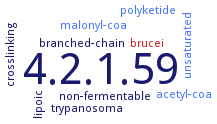4.2.1.59: 3-hydroxyacyl-[acyl-carrier-protein] dehydratase
This is an abbreviated version!
For detailed information about 3-hydroxyacyl-[acyl-carrier-protein] dehydratase, go to the full flat file.

Word Map on EC 4.2.1.59 
-
4.2.1.59
-
trypanosoma
-
brucei
-
acetyl-coa
-
lipoic
-
non-fermentable
-
branched-chain
-
polyketide
-
crosslinking
-
unsaturated
-
malonyl-coa
- 4.2.1.59
-
trypanosoma
- brucei
- acetyl-coa
-
lipoic
-
non-fermentable
-
branched-chain
- polyketide
-
crosslinking
- unsaturated
- malonyl-coa
Reaction
Synonyms
3-hydroxyacyl-ACP dehydratase, AT5G60335, beta-hydroxyacyl-[ACP] dehydratase, Beta-hydroxyoctanoyl-ACP-dehydrase, Beta-Hydroxyoctanoyl-acyl carrier protein dehydrase, D-3-Hydroxyoctanoyl-acyl carrier protein dehydratase, Dehydratase, beta-hydroxyoctanoyl thioester, Dehydratase, D-3-hydroxyoctanoyl-[acyl carrier protein], EC 4.2.1.58, EC 4.2.1.60, EC 4.2.1.61, FabA, FabZ, fatty acid dehydratase, HaHAD1, HaHAD2
ECTree
Advanced search results
Systematic Name
Systematic Name on EC 4.2.1.59 - 3-hydroxyacyl-[acyl-carrier-protein] dehydratase
Please wait a moment until all data is loaded. This message will disappear when all data is loaded.
(3R)-3-hydroxyoctanoyl-[acyl-carrier protein] hydro-lyase (oct-2-enoyl-[acyl-carrier protein]-forming)
This enzyme is responsible for the dehydration step of the dissociated (type II) fatty-acid biosynthesis system that occurs in plants and bacteria. The enzyme uses fatty acyl thioesters of ACP in vivo. Different forms of the enzyme may have preferences for substrates with different chain length. For example, the activity of FabZ, the ubiquitous enzyme in bacteria, decreases with increasing chain length. Gram-negative bacteria that produce unsaturated fatty acids, such as Escherichia coli, have another form (FabA) that prefers intermediate chain length, and also catalyses EC 5.3.3.14, trans-2-decenoyl-[acyl-carrier protein] isomerase. Despite the differences both forms can catalyse all steps leading to the synthesis of palmitate (C16:0). FabZ, but not FabA, can also accept unsaturated substrates [4].


 results (
results ( results (
results ( top
top





